Robotics and nature entwine in the V&A’s beetle-inspired pavilion
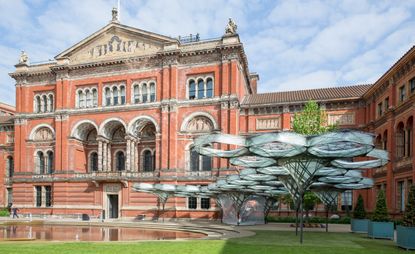
Engineers are too often the unsung heroes of architecture and design, the silent collaborators charged with transforming artistic visions into reality. That is set to change as London's Victoria and Albert Museum kicks off its first ever Engineering Season, launching today with a specially commissioned, site-specific installation in the John Madejski Garden that is both inspired by nature and fashioned by robots.
Conceived by architect Achim Menges, together with Moritz Dörstelmann, structural engineer Jan Knippers and climate engineer Thomas Auer, the newly unveiled 'Elytra Filament Pavilion' comprises an intricate canopy of resin-coated, carbon fibre and glass thread, woven using a unique robotic technique. The pavilion’s cellular, lightweight design draws inspiration from its namesake – elytra is a type of hardened forewing typical of beetles and other insect orders.
The project engineers’ fascination with biomimicry stems from the staggering potential of construction principles found in nature. The pavilion is the next phase in ongoing collaborative research at the University of Stuttgart's Institute of Computational Design and the Institute of Building Structures and Structural Design – helmed by Menges and Knippers, respectively. ‘When we look into rethinking the relation between material and design, nature is a very interesting precedent, because in nature we very often find things that are unexpected in technology,’ explained Menges during our recent visit to Stuttgart, where the pavilion cells were produced individually before being installed at the V&A. ‘We now have increasingly better ways of understanding the principles of natural construction, better tools to simulate them, and now the capacity to fabricate them.’
With the fourth industrial revolution currently underway, ways in which to exploit new materials are coming ever more to the fore. ‘As a structural engineer who grew up in the 1990s with the steel-and-glass architecture of Norman Foster and others, the most transparent, the most daring steel structures were done when this material was only 25 years old,’ says Menges. ‘Nobody knew how to engineer it, nobody had simulations of anything.’ It’s this same pioneering spirit Menges and his forward-thinking band of engineers have championed with the 'Elytra Filament Pavilion', reimagining ways to intertwine the laws of robotics and nature.
The pavilion’s cells are designed to be modular, and will also evolve and grow over the course of the Engineering Season in response to data collected by embedded optical fibres, which will trace the behaviour and pattern of the canopy's inhabitants. Visitors will have a chance to see new cells being crafted in situ by a Kuka robot (a slow, repetitive process – but one that's strangely hypnotic).
Knippers adds, ‘What we try to seek out in these experiments is a set of expressions of the material. Almost all natural load-bearing structures are fibrous composites – although there’s an incredible diversity of natural structures, nature only uses very few materials.’ To wit, if the pavilion is to be admired for its technical prowess, there’s something equally to be said for its aesthetics, from the striking black and mint palette to the intricate pattern of the woven fibres.
The V&A’s Engineering Season continues apace in one month’s time, when the oeuvre of Ove Arup (1895–1988) takes centre stage, in a major retrospective celebrating the most iconic engineer of the 20th century.
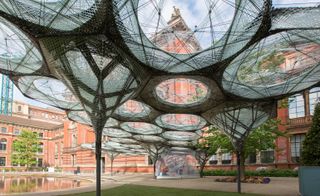
Conceived by architect Achim Menges, together with Moritz Dörstelmann, structural engineer Jan Knippers and climate engineer Thomas Auer, the ’Elytra Filament Pavilion’ comprises an intricate canopy of resin-coated, carbon fibre and glass thread, woven using a unique robotic technique
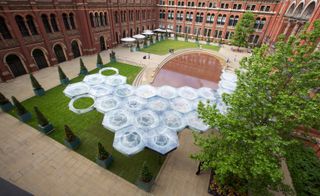
The pavilion’s cellular, lightweight design draws inspiration from its namesake – elytra is a type of hardened forewing typical of beetles and other insect orders
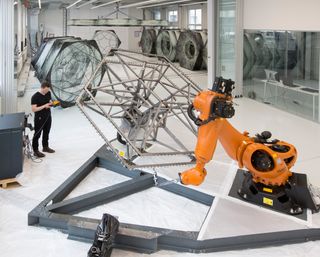
The pavilion is the next phase in ongoing collaborative research at the University of Stuttgart’s Institute of Computational Design and the Institute of Building Structures and Structural Design. It was crafted cell by cell in a laboratory in Stuttgart (pictured), before being assembled in London
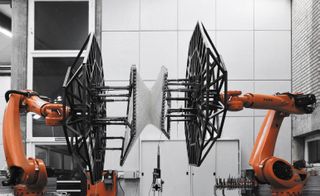
A robotic arm spins glass fibres around a mould
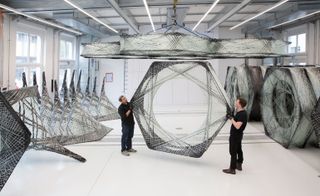
The large components are notably lightweight due to their carbon fibre composition, and are able to be lifted by hand in spite of their size
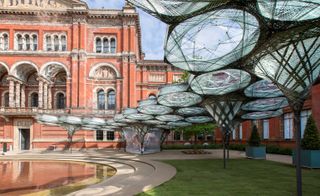
The pavilion’s cells are designed to be modular...
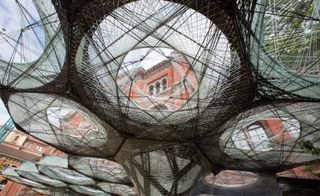
... and will also evolve and grow over the course of the Engineering Season in response to data collected by embedded optical fibres, which trace the behaviour and pattern of the canopy’s inhabitants
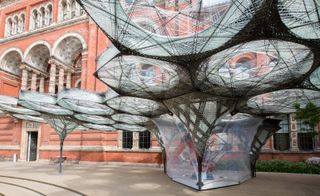
Visitors will have a chance to see new cells being crafted in-situ by a Kuka robot
INFORMATION
The V&A’s Engineering Season is on view until 6 November. ‘Engineering the World: Ove Arup and the Philosophy of Total Design’ opens 18 June. For more information, visit the V&A’s website
Courtesy of the Victoria and Albert Museum, London
ADDRESS
Victoria and Albert Museum
Cromwell Road
London, SW7 2RL
Wallpaper* Newsletter
Receive our daily digest of inspiration, escapism and design stories from around the world direct to your inbox.
-
 Tranquil and secluded, Lemaire’s new Tokyo flagship exudes a sense of home
Tranquil and secluded, Lemaire’s new Tokyo flagship exudes a sense of homeIn Tokyo’s Ebisu neighbourhood, Lemaire’s tranquil new store sees the French brand take over a former 1960s home. Co-artistic directors Christophe Lemaire and Sarah-Linh Tran tell Wallpaper* more
By Joanna Kawecki Published
-
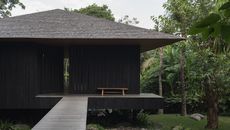 ‘I wanted to create a sanctuary’ – discover a nature-conscious take on Balinese architecture
‘I wanted to create a sanctuary’ – discover a nature-conscious take on Balinese architectureUmah Tsuki by Colvin Haven is an idyllic Balinese family home rooted in the island's crafts culture
By Natasha Levy Published
-
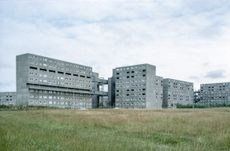 ‘Concrete Dreams’: rethinking Newcastle’s brutalist past
‘Concrete Dreams’: rethinking Newcastle’s brutalist pastA new project and exhibition at the Farrell Centre in Newcastle revisits the radical urban ideas that changed Tyneside in the 1960s and 1970s
By Smilian Cibic Published
-
 Celebrate Día de los Muertos at one of London (and the world’s) finest Mexican restaurants
Celebrate Día de los Muertos at one of London (and the world’s) finest Mexican restaurantsDía de los Muertos will arrive at KOL in Marylebone on 2 November, with a collaborative menu including dishes from the chefs behind Endo at The Rotunda to The Connaught, wrapped up with a mezcal fiesta
By Tianna Williams Published
-
 Mark’s Club’s interior refresh brings British countryside charm to the heart of Mayfair
Mark’s Club’s interior refresh brings British countryside charm to the heart of MayfairLocated in a classic Mayfair townhouse, Mark’s Club unveils its new interiors, from greenhouse extensions to a new open-plan layout full of trinkets and charm
By Tianna Williams Published
-
 Frogs legs to fromage: Café François is London’s newest French canteen, serving up all the classics with a contemporary global twist
Frogs legs to fromage: Café François is London’s newest French canteen, serving up all the classics with a contemporary global twistThe founders of Mayfair's Maison François have opened a new addition, Café François. The Borough-based canteen offers an array of French classics from dawn to dusk
By Tianna Williams Published
-
 Dramatic and immersive, Dosa dishes up Korean cuisine with a moody flair
Dramatic and immersive, Dosa dishes up Korean cuisine with a moody flairThe Mandarin Oriental Mayfair welcomes Dosa, a new Korean restaurant by Akira Back
By Melina Keays Published
-
 Yauatcha’s bespoke mooncakes mark the start of delicious celebrations for Mid-Autumn Festival
Yauatcha’s bespoke mooncakes mark the start of delicious celebrations for Mid-Autumn FestivalYauatcha, London’s Chinese dim sum teahouse, celebrates Mid-Autumn Festival (17 September) with three flavours of limited-edition mooncakes
By Tianna Williams Published
-
 Why bread is back on the menu
Why bread is back on the menuGone are the days of carb-avoidant diets dominating restaurant menus. Food Critic, Leonie Cooper, celebrates the return of pillowy, inventive bread as London's stand-out dish
By Leonie Cooper Published
-
 Birley Chocolate hits the sweet ’n’ chic spot in London’s Chelsea
Birley Chocolate hits the sweet ’n’ chic spot in London’s ChelseaThe new Birley Chocolate shop, a sibling to Birley Bakery, is a confection of colour as delicious as its finely crafted goods
By Melina Keays Published
-
 The London tequila bars well worth a shot
The London tequila bars well worth a shotOur resident spirits writer Neil Ridley explores London’s best places to enjoy the finest agave-based spirits
By Neil Ridley Published